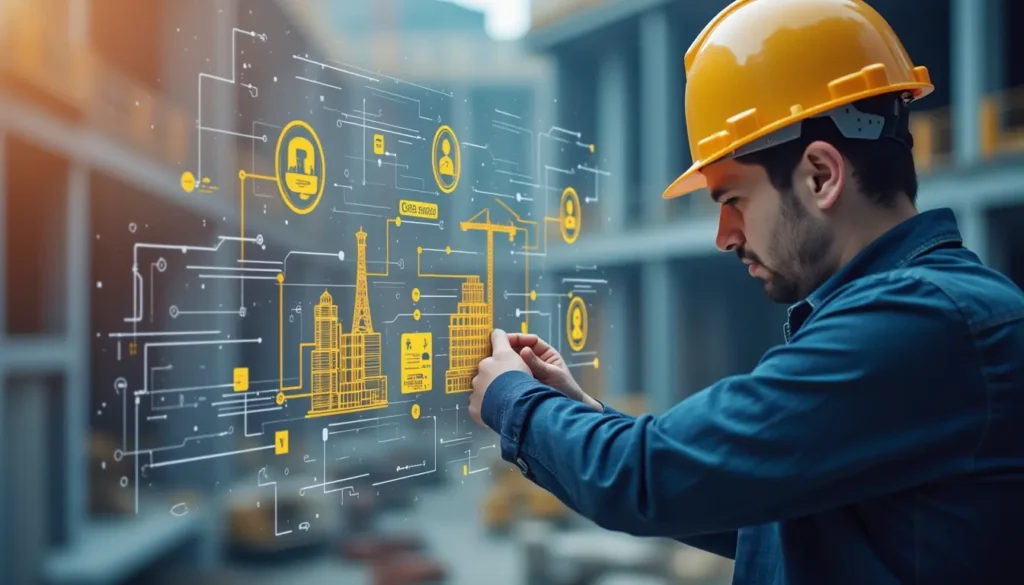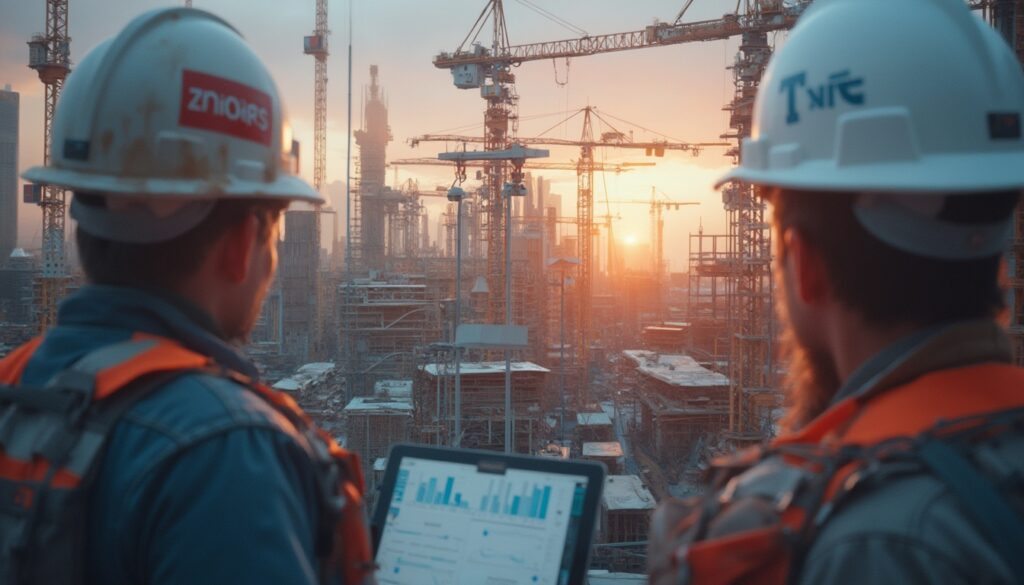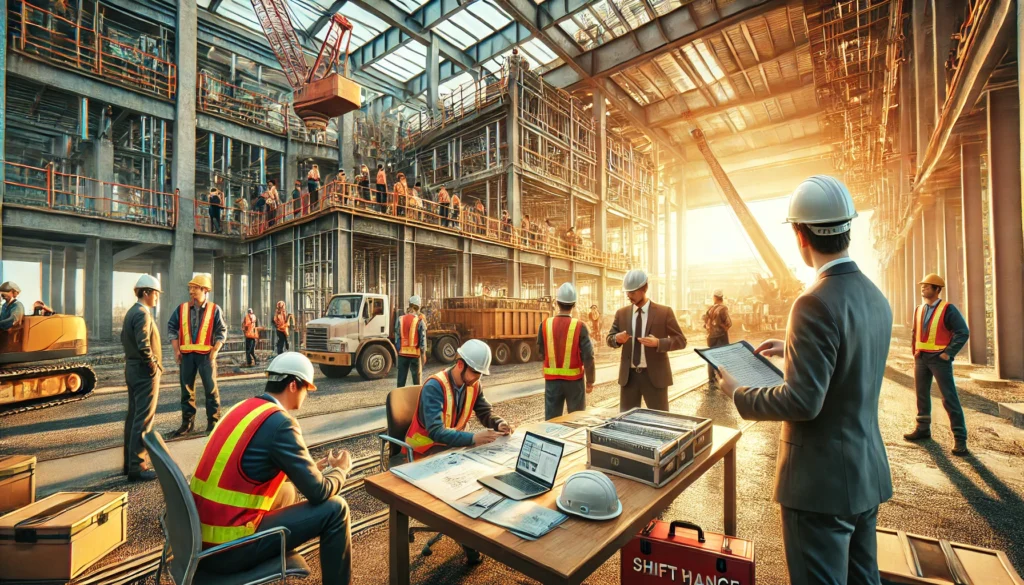Construction industry in transformation: Here’s how to set the course for your success in 2024/2025
The construction industry is on the move – and how! Technological advancements, new market demands, and the increasingly loud call for more sustainability are shaking things up. Those who keep track of the current trends in the construction industry will clearly have the upper hand. That’s what this article is about: We want to show you which developments you, as a construction company, should have on your radar now to ensure success tomorrow. We at Valoon GmbH know firsthand how important it is not only to be aware of these developments but also to have suitable responses ready – with solutions that are truly tailored to the needs of the construction industry. Do you need a partner for the digitalization of your construction projects or want to take your communication to the next level? Then just reach out to us – we are happy to provide personalized advice.
- The construction industry is being transformed by technological advancements, new market demands, and the call for sustainability.
- Current challenges include a shortage of skilled labor, fluctuating material prices, and the housing crisis.
- Digital technologies like BIM and AI offer enormous opportunities for increasing efficiency and reducing costs.
- Trend competence, especially in digitization and sustainability, secures competitive advantages.
Master challenges and opportunities in the current market environment
Sure, the construction industry faces some hurdles: the ongoing shortage of skilled labor, fluctuating material prices, and the need to become more ecological are just a few of them. Thus, the German construction industry had to accept another setback in orders and revenue in 2024 according to reports. But where there is shadow, there is also light! Digital technologies like Building Information Modeling (BIM) and Artificial Intelligence (AI) offer huge opportunities to work more efficiently, cut costs, and improve quality. The current trends in the construction industry trends clearly show: The journey is heading towards digitized, data-driven, and sustainable construction processes. A development in the construction industry, which cannot be ignored.
And then there’s the often-discussed housing crisis. With a projected deficit of up to 60% in completions relative to demand (we are talking about 160-240,000 units built against a need of 385-400,000), it is clear: Construction companies need to rethink strategically and diversify. We see great opportunities in the area of ‘renovation’ and in developing new, cost-effective housing concepts. Those who proactively adjust to these special trends in the construction industry conditions not only ensure their survival but also secure growth opportunities. Another challenge we passionately address at Valoon GmbH is the promotion of the acceptance of new technologies. Especially in more traditional industries, this is not always easy. That’s why our software solutions are designed to be particularly user-friendly – making the transition to digitalization as easy as possible.
Securing competitive advantages through trend competence
Let’s be honest: Understanding the current trends in the construction industry trends and quickly adapting is no longer an option for construction companies, but a must in order to succeed in the tough competition. Those who strategically focus early on key topics such as digitization in the construction industry and well thought-out sustainability concepts can achieve real and long-term advantages. The ability to respond flexibly and well-informed to these developments is increasingly becoming the deciding factor for long-term success. Let’s take BIM as an example: It’s much more than just new software. It requires real investments in training, software, hardware, and yes, also in adjusting internal processes. A solid data foundation and smooth communication with clients and trades are the essential ingredients.
Goal setting: A compass for construction industry trends
With this article, we want to provide you with a compass – a comprehensive and practical overview of the most important trends in the construction industry trends for 2024 and 2025. We take a close look at what is moving the industry: the ongoing digitization, the introduction of BIM, the growing importance of sustainability and ESG criteria, the potential of modular construction and industrial prefabrication, as well as the increasing influence of artificial intelligence (AI) in construction. Because only those who understand these diverse developments can make smart strategic decisions. We show you how these developments turn traditional working methods upside down and what concrete steps your company can take to benefit from them. We at Valoon GmbH help you to master these trends in the construction industry changes. How? By transforming everyday messenger communication, such as through WhatsApp, into structured and valuable project data. This sustainably improves the flow of information and the overall project management.Shortage of skilled labor? Here’s how to tackle it – with digitization and BIM!
The shortage of skilled labor – a topic that’s causing quite a stir in the German construction industry and often acts like a real brake. But instead of burying our heads in the sand, let’s look forward! Because digital tools and methods like Building Information Modeling (BIM) offer excellent approaches to counteract and boost efficiency on job sites. The current trends in the construction industry trends make it clear: It’s high time to act resolutely.
- The shortage of skilled labor, caused by demographics and migration, presents a significant challenge.
- Digital solutions like automation and ERP systems can increase productivity and counteract the shortage.
- Building Information Modeling (BIM) revolutionizes planning and execution processes through digital twins.
- Promoting digital skills and modern working methods is crucial to make the industry more attractive.
Addressing the acute shortage of skilled labor with intelligent strategies
Yes, the shortage of skilled labor construction industry has many faces and deep-rooted causes. Demographic change is one of them: Experienced workers are retiring, and the next generation for construction jobs is slow to arrive. We must make the industry more attractive for young talents again! Additionally, qualified people sometimes migrate to other, supposedly cooler industries. This naturally heightens the competition for good employees and drives up wage costs. The trends in the construction industry current trends signal clearly: Without clever counter-strategies, capacities will continue to shrink. Studies also show that the lack of digital skills (in 32% of skilled workers) is a major obstacle to digitalization on our construction sites.
Digitalization as an opportunity: Increasing efficiency through automation and intelligent systems
Digitalization is a true game-changer here! It offers us so many opportunities to outsmart the shortage of skilled labor and enhance productivity. An important aspect is the automation of routine tasks – this creates free spaces and increases efficiency. Think of mobile job site apps or digital time tracking systems: They significantly reduce paperwork and assist in more accurate personnel planning. Strong trends in the construction industry innovations are absolutely pioneering for the future of the construction industry.
BIM (Building Information Modeling): Revolutionizing planning and execution
Building Information Modeling (BIM) is so much more than just a fleeting software trend – it’s a comprehensive method for holistic digital construction planning and execution. With BIM, we create a detailed digital twin of a construction project that consolidates all important information about the entire lifecycle. The benefits are evident: fewer planning errors, optimized material consumption, shorter construction times, and much better collaboration among all parties involved. Yet, there is still considerable room for improvement regarding the widespread use of BIM in the DACH region (Germany, Austria, Switzerland). The current trends in the construction industry trends, however, show unequivocally: BIM is a key technology for the digital transformation in construction. And its potential is far from being fully tapped, especially regarding the integration with sustainability strategies and material optimization. By the way: We at Valoon GmbH make data collection on-site very easy – and this data can then be seamlessly integrated into your BIM processes.Building greener, competing stronger: Cleverly utilizing ESG, circular economy, and timber construction
Sustainability has long ceased to be a fringe topic in the construction industry – on the contrary, it is increasingly becoming a genuine competitive advantage and a business necessity. Those who integrate ESG criteria, stimulate the circular economy, and increasingly rely on renewable resources like timber not only follow crucial trends in the construction industrytrends but actively shape the sector sustainably and future-proof.
- Integrating ESG criteria (Environmental, Social, Governance) is becoming increasingly important strategically for construction companies.
- Shifting towards a circular economy aims to reduce primary resources and minimize waste through recycling and upcycling.
- Local sourcing and resource-efficient construction methods are essential for ecological and economic advantages.
- Timber construction offers significant potential for sustainable building as a renewable, CO2-binding resource that must be utilized better.
ESG criteria (Environmental, Social, Governance) as a strategic imperative
Adhering to ESG criteria is becoming increasingly crucial for construction companies. And not just to meet legal requirements like the Corporate Sustainability Reporting Directive (CSRD)! A well-thought-out sustainability strategy that combines ecological, social, and corporate aspects is a clear advantage in convincing investors and solidifying one’s good reputation. This also includes making emissions data transparent and adjusting processes and supply chains. The trends in the construction industry trends clearly show: Companies that view sustainability as an integral part of their strategy are more successful in the long run. We at Valoon GmbH support you with digital documentation that helps you efficiently capture even ESG-relevant data.
Circular economy and resource efficiency: Minimizing waste, creating value
The shift towards a circular economy is another important trend we should keep an eye on. The goal is clear: consume fewer primary resources and reduce waste as much as possible by recycling or upcycling construction materials. This not only protects our environment but can also save real money. A focus on local sourcing is incredibly valuable: It reduces CO2 emissions through shorter transport routes and makes us less dependent on global supply chains, which, as you know (keyword material shortages), can be quite vulnerable at times. An energy- and resource-saving construction method, which for example relies on modern techniques and efficient building technology, is simply a must today. These trends in the construction industry approaches require a rethink in planning and execution – but it’s worth it!
Timber construction: Unlocking the potential of a sustainable building material
Der Timber construction is a real hope for climate protection and resource-efficient building. Timber is a renewable resource that binds CO2 during its growth and thus actively helps to reduce greenhouse gases. The sustainable construction industry is increasingly relying on this brilliant building material. Although we have enough timber in Germany, we are still not fully utilizing the potential of timber construction, especially in multi-storey residential and commercial construction. What’s the problem? Often there is a lack of trained specialists, and sometimes persistent, outdated reservations about fire protection remain. Promoting timber construction through targeted educational programs, adjusted building regulations, and honest education about its many benefits is crucial. trends in the construction industry, to make this sustainable building material even stronger. And here too, a precise documentation of construction progress, as enabled by our software at Valoon, is a huge advantage, especially in timber construction.Turbo for your projects: Modular construction and prefabrication as efficiency boosters
In light of the ongoing labor shortage and increasing cost pressure, modular construction and industrial prefabrication are becoming central trends in the construction industry focused more and more. These trends in the construction industry are crucial, as these methods not only promise faster construction times and higher quality but also better resource utilization and more flexibility in planning and execution.
Industrial prefabrication as a significant growth driver
Die industrial prefabrication of building components is becoming one of the most important growth engines for the construction supply industry and the entire construction sector. The skilled labor shortage directly on construction sites is further accelerating this trend. Prefabrication in the factory takes place in all weather conditions and under controlled circumstances – the result is components of consistently high quality and precision. This creates a whole new, parallel value chain with direct sales and industrial marketing, which stands out from the traditional, more craft-oriented models. The standardization of components and processes is a key to success, but it also requires us to rethink the entire value chain – from planning to assembly. These trends in the construction industry transform the way we plan and build buildings fundamentally and have a major impact on the development of the construction industry in 2024.
Modular construction: A quick and sustainable answer to the housing shortage
Das modular construction, where entire room modules are prefabricated in the factory and are essentially only assembled on-site, is a truly effective response to the pressing housing shortage and the demand for quick yet sustainable building solutions. Through the flexible production of serially manufactured components, we can easily adapt to diverse requirements and drastically shorten construction times. This saves costs through more efficient material use and shorter project durations. Modular construction also drives innovations in design and material use while minimizing weather impacts and safety risks on the construction site. Digitalization plays a key role here, as it supports the precise planning and control of prefabrication processes. The trends in the construction industry show that interest in this construction method is steadily growing, even for larger projects.
3D printing in construction: From niche to industrial application
Der 3D printing in construction, especially with concrete, has exciting future potential, even though the technology is still in its infancy. Current trends in the construction industry indications suggest that 3D printing will be used less directly on construction sites and more in the prefabrication of complex building components and formworks. This technology allows us to quickly develop prototypes, manufacture custom components, and produce significantly less waste through precise material application. By combining 3D printing with other digital tools like BIM, further efficiency leaps are possible. We at Valoon GmbH are closely monitoring this development, as efficient communication and data collection are absolutely crucial when integrating new manufacturing methods.
Important aspects of modular construction and prefabrication
To fully exploit the advantages of these construction methods, we should keep several points in mind:
- Standardization and systematization: The development of standardized modules and components is essential for scalability and cost-effectiveness.
- Digital planning tools: Without BIM and other digital helpers, precise planning, coordination, and manufacturing control are almost impossible.
- Logistics and assembly: Well-thought-out logistics for transporting and assembling prefabricated components on-site is critical to success.
- Quality assurance: Continuous quality checks, both in the factory and on site, ensure that standards are met.
The future is now: How AI, robotics, and digital twins are revolutionizing your construction processes
The construction industry is currently experiencing a wave of technological innovations that have the potential to turn traditional processes upside down. Artificial intelligence (AI), robotics, and digital twins are leading the charge – as central trends in the construction industry, which can elevate efficiency, precision, and sustainability to a whole new level.
Artificial intelligence (AI) in construction: Data-driven efficiency and optimized processes
Artificial intelligence (AI) is conquering more and more areas of the construction industry and is shaking things up. According to reports, the market value of AI in construction was estimated at over 2.5 billion US dollars in 2022 – and it is expected to grow by 20% annually! Already today, 74% of companies use AI in projects, primarily in design (48%) and planning (42%). AI-powered systems analyze massive amounts of data to identify patterns, optimize processes, and make predictions. The application fields are diverse: from automated waste classification and recycling to optimizing construction workflows and resource use, including predictive maintenance of machinery. The trends in the construction industry show that 84% of companies plan to increase their AI investments in the next five years, although a lack of regulatory frameworks and insufficient expertise sometimes slow down implementation. At Valoon GmbH, we focus on the automatic structuring of communication data – an important precursor to intelligent data analysis, supporting the use of artificial intelligence in the construction industry.
Robotics and autonomous construction sites: Increasing productivity and relieving skilled workers
The use of robots and autonomous machines on construction sites is another promising trend to increase efficiency, enhance precision, and improve safety. Robots can take over monotonous, physically demanding, or dangerous tasks, thereby relieving our skilled workforce – an important contribution in the fight against the skilled labor shortage. Potential application areas include masonry, welding, material transport, or inspection of hard-to-reach areas. Although the demand for robotics in infrastructure construction is rising, the high costs in building construction still present a challenge. The trends in the construction industry indications suggest that especially infrastructure projects will drive automation forward. The transition to the autonomous construction site is a long-term goal that we will achieve step by step through the integration of intelligent systems.
Digital twins: Real-time data analysis and transparent visualization of construction projects
Digital twins are virtual replicas of real buildings, facilities, or even entire cities. They are fed with real-time data from sensors (IoT) and thus enable continuous monitoring, analysis, and simulation of construction projects and their operation. This technology revolutionizes our construction processes by creating a transparent data basis for all parties involved, allowing us to visualize changes or conditions of buildings in real time. When combined with BIM, digital twins can reduce error rates, help save material, and increase efficiency over the entire lifecycle of a building. The trends in the construction industry show a rapidly growing interest in this technology, as it enables more accurate planning, more efficient execution, and an optimized building operation. We at Valoon GmbH support you in easily capturing the necessary data on the go.Stormy times, clear strategies: Navigating material shortages, data security, and climate risks
The construction industry is operating in an increasingly uncertain environment. Material shortages, rising prices, new demands for data security, and the growing impacts of climate change are challenging us. Successful companies now need proactive strategies to tackle these challenges and leverage the associated trends in the construction industry to their advantage. Understanding these trends in the construction industry is crucial for future viability.
Dealing with material shortages and price increases
Persistent material shortages, especially for raw materials like steel, petroleum products, and bitumen, as well as significant price increases, pose real challenges for construction projects. The costs for new residential buildings have surged considerably. A wise response is the prioritization of local sourcing. This not only stabilizes supply chains but also reduces CO2 emissions through shorter transport distances – a win-win situation! Additionally, energy- and resource-saving construction methods, along with excellent cash management, are essential to cushion cost increases and secure liquidity. The trends in the construction industry require a shift towards more resilient supply chains and an even more efficient use of resources. The digital monitoring of material needs and consumption, as supported by our software at Valoon, can provide the necessary transparency.
Data security and integration as digital challenges
The ongoing digitalization brings us huge advantages but also presents new tasks in the area of data security and privacy. Particularly when integrating third-party messaging services or utilizing cloud platforms, the highest security standards must be applied – there are no compromises. Another hurdle is often the complex integration of new digital solutions into existing, sometimes still analog systems and processes. Mastering these digitalization challenges requires not only technical know-how but also careful planning and well-trained employees. The trends in the construction industry indicate that investments in cybersecurity and systems that can ‘talk’ to each other (interoperable systems) are essential. We at Valoon GmbH place the utmost importance on data security and seamless integration of our solutions – you can rely on that.
Adapting to climate risks and promoting resilient construction methods
Climate change is altering the risk profile of real estate investments and construction projects. Factors like urban heat islands, water scarcity, and extreme weather events need to be considered much more seriously in planning and assessments than in the past. The integration of climate risk analyses into due diligence processes (that is, the careful examination before decisions) is an important step. Furthermore, it is crucial to promote climate-resilient construction methods – those that consider overheating protection, smart water management, and robust materials. The trends in the construction industry indicate a rising demand for buildings that are adapted to changing climatic conditions. The topic of climate insurance is also gaining importance, as many companies are still underinsured.
Strategic approaches to managing the challenges
To effectively address the complex challenges, construction companies should consider the following strategic approaches:
- Diversification of supply chains: Less dependence on individual suppliers and regions makes us more resilient.
- Implementation of lean construction management: Eliminating waste and optimizing processes to increase efficiency – that’s the goal.
- Investment in digital skills: Preparing our staff to handle new technologies and digital tools.
- Development of sustainability strategies: Integrating ESG criteria holistically into the business model.
Digital helpers with power: Software and platforms as the engine of your transformation
Software solutions and digital platforms are much more than just nice tools – they are the essential enablers of change in the construction industry. They enable more efficient collaboration, optimize processes, and help companies like yours tackle the diverse trends in the construction industry to successfully seize opportunities and remain competitive.
CRM Systems: Optimized Customer Communication and Partner Coordination
Customer Relationship Management (CRM) systems are becoming increasingly important in the construction industry. Why? Because they provide a optimized customer communication throughout the entire project lifecycle – from the initial inquiry to post-project support. But that’s not all: CRM systems also improve coordination with business partners and suppliers by keeping all relevant information centralized and readily accessible. The result: fewer misunderstandings, faster response times, and ultimately, happier customers. The trends in the construction industry show that professional customer care and retention are increasingly becoming key success factors. We at Valoon GmbH understand the importance of structured communication and offer solutions that can seamlessly integrate into your overarching management systems.
Construction Management Tools for Connected Work and Improved Project Coordination
Modern construction management tools, such as BauMaster or our own platform here at Valoon GmbH, are designed to enable truly seamless collaboration among all project participants. They build bridges between the office and the construction site, close information gaps, and minimize misunderstandings. Features such as a centralized task management system, digital data collection directly on-site (for example, through messengers like WhatsApp), intelligent reporting (think photo documentation, measurements, daily reports), and a cloud-based project storage are invaluable for mastering the complexity of today’s construction projects. Such tools assist you in implementing the current trends in the construction industry by simplifying data collection and sustainably improving the flow of information. The construction industry 2025 will be significantly shaped by such smart tools.
Cloud Solutions: Flexibility, Scalability, and Automated Collaboration
Cloud-based Software-as-a-Service (SaaS) platforms offer tremendous flexibility and scalability – and that for construction companies of all sizes. They allow access to project data and features from anywhere, at any time. This is particularly convenient for companies with many field employees or those in different locations. Cloud solutions make real-time collaboration a breeze and can automate many routine tasks. This notably enhances agility and efficiency in your construction projects. The integration of messaging services with advanced features like buttons, lists, and forms, as we offer at Valoon GmbH, is a great example of how cloud technology can simplify and structure communication. The trends in the construction industry indicate a clear trend: away from paperwork and towards mobile and cloud-based technologies that could finally retire the paper-based construction process.Looking Ahead: What Will Move the Construction Industry by 2030 – and How You Can Help Shape the Future
The construction industry stands on the threshold of a decade that will bring profound changes. The trends in the construction industry, that will accompany us until 2030, are diverse and characterized by constant innovation. These trends in the construction industry include the development of new business models and an increasing responsibility concerning our climate goals. Companies that proactively position themselves now and remain adaptable will emerge as winners from this transformation.
The necessity for continuous innovation and adaptability
In a rapidly changing market environment, the ability for continuous innovation and adaptation is no longer a nice extra, but simply vital. This applies not only to the introduction of new technologies but also to optimizing processes, developing new services, and tapping into new markets. We need to establish a culture of openness and learning within our companies to respond flexibly to unforeseen developments. The trends in the construction industry, such as neo-ecology – a solution-oriented approach to sustainability that combines ecological, social, and technological aspects – compel us to constantly question existing practices. We at Valoon GmbH are committed to continuously developing our software solutions to meet the changing needs of the construction industry.
Emergence of New Business Models and Changed Value Chains
Digitization and a strong focus on sustainability are leading to the emergence of new business models and the transformation of existing value chains.Platform economies, sharing models for construction machinery (think rental platforms), data-driven services, and specialized providers for modular or sustainable construction concepts are gaining more significance. The traditional boundaries between planners, builders, and operators are increasingly blurring. The trends in the construction industry indicate a stronger networking and cooperation along the entire value chain. Companies need to reconsider their positioning and explore cooperation opportunities to succeed in these new ecosystems. The ability to intelligently use data and convert it into structured, valuable information – as our platform at Valoon enables – will become ever more important.
The Central Role of the Construction Industry in Achieving Climate Goals
The construction sector plays an absolutely central role in achieving global and national climate goals.Buildings are responsible for a significant share of CO2 emissions and resource consumption – that is a fact. The trends in the construction industry make it unmistakably clear: The pressure to reduce our ecological footprint will continue to increase. This requires a massive expansion of energy-efficient building practices (keyword net-zero buildings), increased use of renewable energy, consistent promotion of the circular economy (i.e., recycling and upcycling of construction materials), and greater utilization of CO2-absorbing materials like wood. The construction industry has the responsibility but also the tremendous opportunity to make a significant contribution to climate protection through innovative solutions. We at Valoon GmbH support this transformation through efficient digital processes that help conserve resources and make projects more sustainable.
Key Action Areas for the Construction Industry by 2030
To set the course for a successful future, companies in the construction industry should prioritize the following action areas at the top of their agenda:
- Investments in Research and Development: Actively promote new technologies, materials, and construction methods.
- Building Digital Competencies: Train employees and attract digital natives to the industry.
- Strengthening the Circular Economy: Develop and implement strategies for disassembly, reuse, and recycling.
- Encouraging Collaborations: Establish partnerships along the value chain to jointly develop innovative solutions.
The current trends in the construction industry clearly indicate: Digitalization, sustainability, and efficiency are the keys to success. Companies that act now and implement innovative solutions secure decisive competitive advantages. We at Valoon GmbH are here to support you as a partner in optimizing your communication and project management processes and preparing you for the future of the construction industry . Take advantage of the opportunities that arise from the transformation of the construction industry! Contact us today for personalized advice and discover how our software can help you convert everyday messenger communication into structured project data and make your projects more efficient.
How can I effectively address the skills shortage in my construction company?
The skills shortage is a central challenge. One solution lies in the digitalization and automation of processes.Mobile construction apps, such as those offered by Valoon GmbH, simplify data collection and communication, enabling existing teams to work more efficiently and require less time for administrative tasks. Additionally, the use of modern technologies increases the attractiveness of the industry for young talent..
Is Building Information Modeling (BIM) relevant and implementable for my medium-sized construction company?
Yes, BIM is increasingly relevant for SMEs. It allows for better planning, reduces errors and material consumption.The entry point need not be complex; start with the digital collection of project data that can later be integrated into BIM processes. Solutions that convert unstructured data (e.g., from WhatsApp) into usable project data,like those from Valoon GmbH, significantly lower the entry barrier.
How can I practically implement sustainability (ESG) in my construction company without letting costs skyrocket?
Sustainability begins with resource efficiency and optimized planning.Digital documentation of material consumption and construction progress helps reduce waste and optimize resource use. Regional sourcing and focusing on durable materials are further steps. Tools that enable a transparent project documentation also assist in proving ESG criteria, which in turn can increase the competitiveness. What are the greatest advantages of modular construction and prefabrication for my company?
Was sind die größten Vorteile von modularem Bauen und Vorfertigung für mein Unternehmen?
Modular construction and prefabrication offer significant time savings through parallel manufacturing in the factory and on the construction site. They lead to higher quality due to controlled manufacturing conditions and can reduce costs through optimized material use.Moreover, weather dependence is reduced and work safety is improved.
What concrete benefits does artificial intelligence (AI) bring to my construction company today?
AI can already help to optimize processes and improve decision-making.One example is the automatic structuring of communication data, as enabled by Valoon GmbH. This creates a clean data foundation for later AI analyses,e.g., for pattern recognition in construction processes or for optimizing resource utilization. The automated translation of communication can also overcome language barriers.
How do I ensure that digitalization supports my employees rather than overwhelms them?
The key lies in easy-to-use and intuitive solutions.Focus on technologies that integrate into familiar workflows. Using familiar tools like WhatsApp for professional data collection,as enabled by Valoon GmbH, lowers acceptance barriers and reduces training efforts. The focus must be on the simplification of daily work. How can I make communication between the construction site and the office more efficient and avoid information loss?
Wie kann ich die Kommunikation zwischen Baustelle und Büro effizienter gestalten und Informationsverluste vermeiden?
A centralized platform that bundles and structures information in real-timeis crucial. When field staff can easily capture data via messenger and this is automatically transformed into project tasks and reports, the information flow accelerates and misunderstandings are reduced.Valoon GmbH specializes exactly in optimizing the communication and making project data usable..
What first step should I take towards digitalization if my budget is limited and I want to see results quickly?
Start with optimizing communication and mobile data collection.Introducing a simple solution for digitally recording daily construction reports, photo documentation, or measurements directly from the construction site via smartphone can already bring significant efficiency gains and reduce paperwork.Solutions that build on existing messaging services are often cost-effective and quick to implement.








